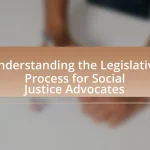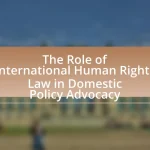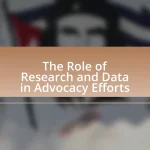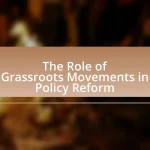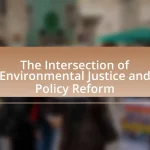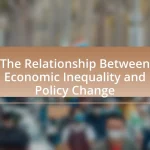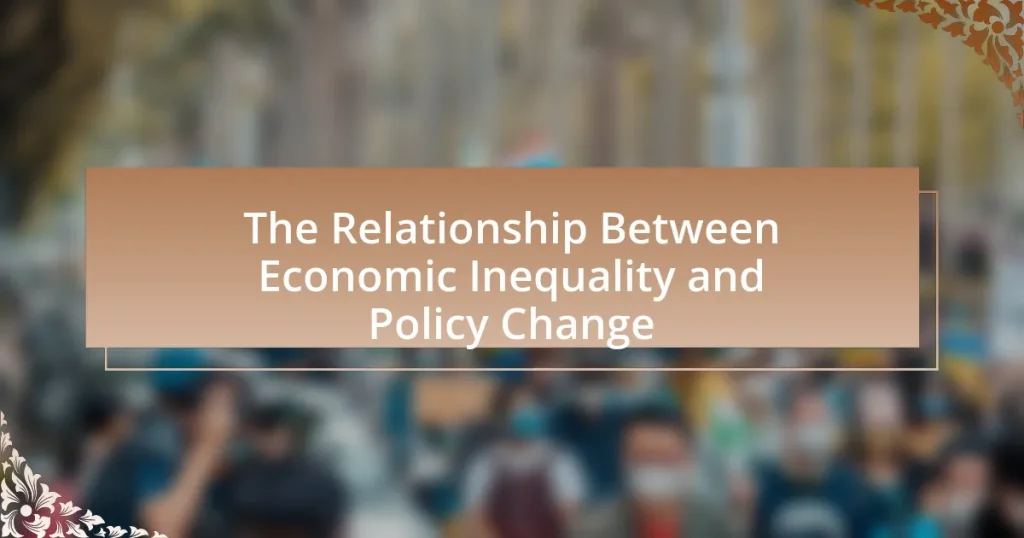The article examines the relationship between economic inequality and policy change, highlighting how disparities in wealth and income influence political priorities and legislative actions. It discusses the mechanisms through which economic inequality drives policy decisions, including the impact of political power dynamics, public opinion, and lobbying by interest groups. The article also explores how policymakers respond to rising inequality through progressive taxation, social welfare programs, and labor market reforms, while emphasizing the importance of understanding this relationship for social stability and economic growth. Additionally, it outlines successful policy interventions and best practices for addressing economic inequality effectively.
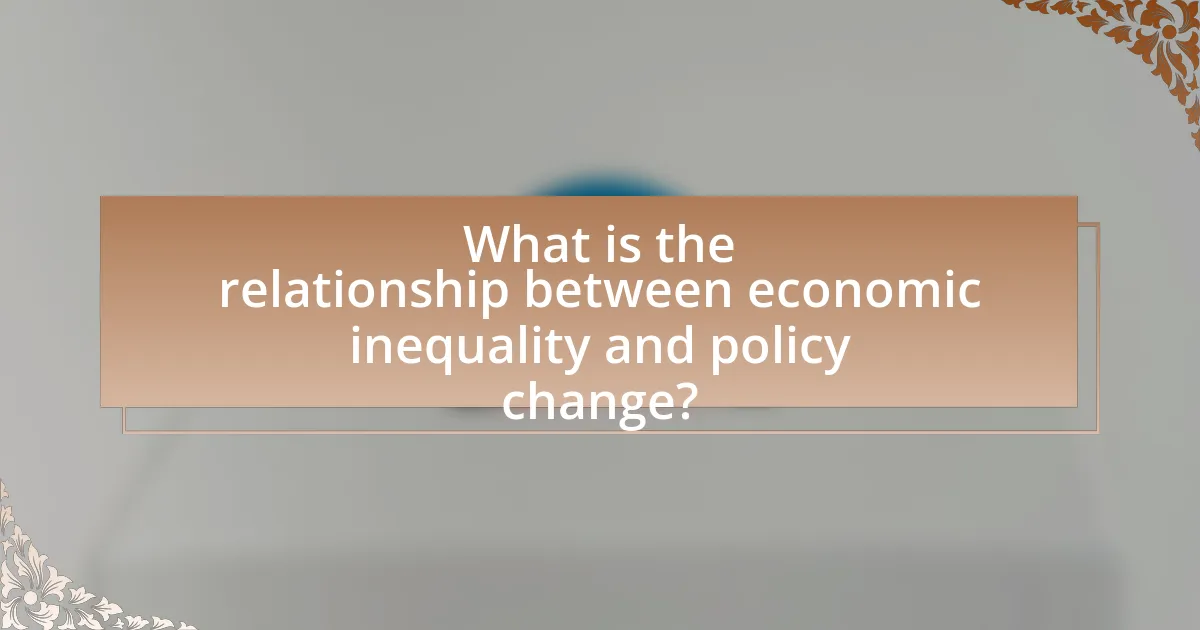
What is the relationship between economic inequality and policy change?
Economic inequality significantly influences policy change, as disparities in wealth and income can lead to shifts in political priorities and legislative actions. When economic inequality rises, it often prompts calls for reforms aimed at wealth redistribution, social safety nets, and increased taxation on the wealthy. For instance, research by the International Monetary Fund indicates that higher levels of inequality can hinder economic growth and lead to political instability, which in turn pressures governments to implement policies that address these disparities. Additionally, historical examples, such as the New Deal in the United States during the Great Depression, illustrate how economic crises and rising inequality can catalyze substantial policy changes aimed at reducing inequality and promoting economic equity.
How does economic inequality influence policy decisions?
Economic inequality significantly influences policy decisions by shaping the priorities and preferences of policymakers. When wealth is concentrated among a small segment of the population, those individuals often have greater access to political power and resources, allowing them to advocate for policies that favor their interests. For instance, research by Gilens and Page (2014) in “Testing Theories of American Politics: Elites, Interest Groups, and Average Citizens” demonstrates that economic elites have a disproportionate impact on policy outcomes compared to average citizens, particularly on issues like tax policy and social welfare. This dynamic can lead to the implementation of policies that exacerbate inequality, as the interests of the wealthy are prioritized over those of the broader population.
What are the key factors that link economic inequality to policy change?
Economic inequality influences policy change through several key factors, including political power dynamics, public opinion, and economic interests. Political power dynamics indicate that wealthier individuals and groups often have greater access to policymakers, allowing them to shape legislation in their favor. For instance, research by Gilens and Page (2014) demonstrates that the preferences of the affluent significantly impact policy outcomes, while those of lower-income citizens have minimal influence.
Public opinion also plays a crucial role; rising economic inequality can lead to increased public awareness and demand for policy reforms aimed at reducing disparities. For example, studies show that when economic inequality reaches a certain threshold, it can trigger social movements advocating for change, as seen in the Occupy Wall Street movement.
Lastly, economic interests drive policy change as businesses and corporations respond to inequality by lobbying for regulations that may either mitigate or exacerbate disparities. The interplay of these factors illustrates how economic inequality serves as a catalyst for policy shifts, shaping the legislative landscape in response to societal pressures and power structures.
How do policymakers respond to rising economic inequality?
Policymakers respond to rising economic inequality by implementing progressive taxation, increasing social welfare programs, and enacting labor market reforms. For instance, progressive taxation aims to redistribute wealth by taxing higher incomes at increased rates, which has been shown to reduce income disparity. Additionally, social welfare programs, such as unemployment benefits and food assistance, are expanded to support lower-income individuals, thereby alleviating poverty and inequality. Labor market reforms, including raising the minimum wage and strengthening workers’ rights, are also pursued to ensure fair compensation and improve living standards for low-wage workers. These strategies are supported by research indicating that such policies can effectively narrow the income gap and promote economic equity.
Why is understanding this relationship important?
Understanding the relationship between economic inequality and policy change is crucial because it directly influences social stability and economic growth. High levels of economic inequality can lead to social unrest and decreased public trust in institutions, which in turn can hinder effective policy implementation. Research from the International Monetary Fund indicates that countries with higher inequality experience slower economic growth, as wealth concentration limits opportunities for broader segments of the population. This correlation underscores the importance of addressing economic disparities to foster inclusive policy changes that promote equitable growth and social cohesion.
What implications does economic inequality have on social stability?
Economic inequality significantly undermines social stability by fostering discontent and increasing the likelihood of social unrest. When wealth is concentrated in the hands of a few, it creates disparities in access to resources, education, and opportunities, leading to feelings of marginalization among lower-income groups. Historical evidence shows that societies with high levels of economic inequality, such as those in Latin America, often experience higher rates of crime and political instability. For instance, the World Bank reported that countries with greater income inequality tend to have weaker social cohesion and higher incidences of civil conflict. This correlation indicates that economic inequality not only affects individual well-being but also poses a threat to the overall stability of societies.
How does economic inequality affect public trust in government?
Economic inequality negatively affects public trust in government by creating perceptions of unfairness and exclusion among lower-income individuals. Research indicates that as income disparity increases, individuals in lower socioeconomic positions feel marginalized and believe that government policies favor the wealthy, leading to decreased trust in governmental institutions. For instance, a study by the Pew Research Center found that in countries with high economic inequality, citizens are more likely to express distrust in their governments, with 70% of respondents in the U.S. indicating that they feel the government serves the interests of the wealthy rather than the general public. This erosion of trust can result in lower civic engagement and diminished support for government initiatives, further perpetuating the cycle of inequality.
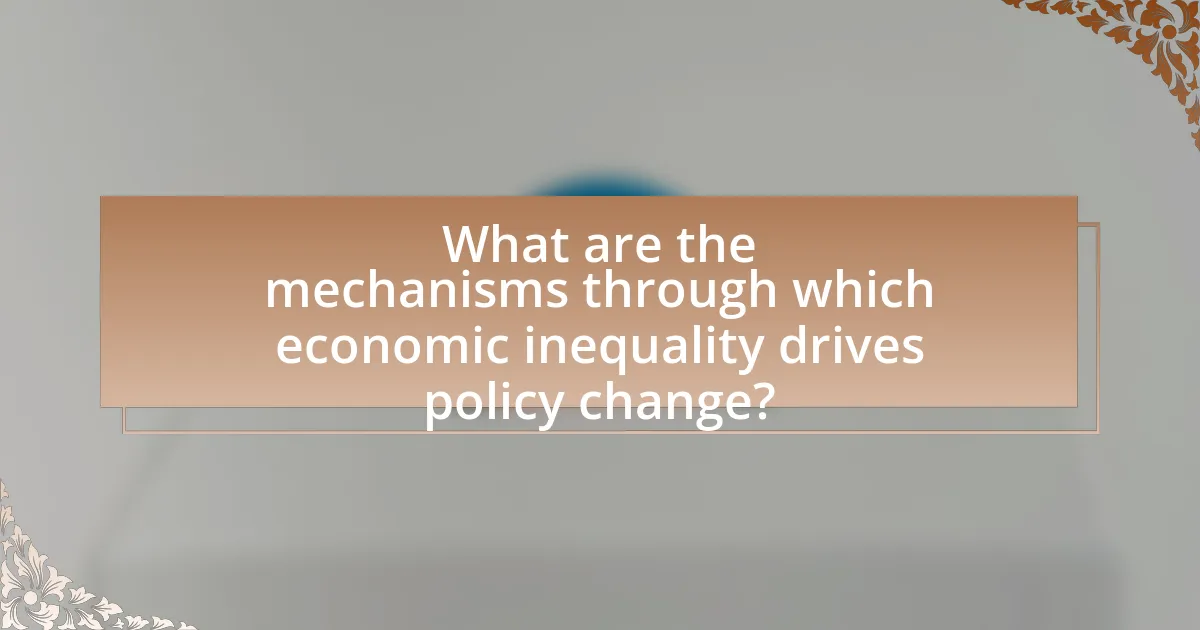
What are the mechanisms through which economic inequality drives policy change?
Economic inequality drives policy change primarily through the influence of wealth on political power and the resulting shifts in public opinion. Wealthy individuals and corporations often have greater access to political decision-makers, enabling them to lobby for policies that favor their interests, such as tax cuts or deregulation. This influence is evidenced by the 2010 Citizens United v. FEC Supreme Court decision, which allowed for unlimited corporate spending in elections, significantly amplifying the voice of the wealthy in shaping policy.
Additionally, economic inequality can lead to social unrest and demands for reform, prompting policymakers to respond to the needs of the disadvantaged. For instance, the Occupy Wall Street movement highlighted growing disparities in wealth and led to increased discussions around income inequality and financial regulation. This demonstrates how public pressure can catalyze policy changes aimed at addressing economic disparities.
Furthermore, research indicates that higher levels of economic inequality correlate with lower levels of social mobility, which can create a feedback loop where disadvantaged groups push for policies that promote equity, such as increased access to education and healthcare. Studies, such as those by the International Monetary Fund, show that reducing inequality can lead to more sustainable economic growth, further incentivizing policymakers to consider reforms that address these disparities.
How do interest groups and lobbying play a role?
Interest groups and lobbying significantly influence policy change by advocating for specific interests and shaping legislative agendas. These entities mobilize resources to persuade lawmakers, often leveraging financial contributions, expert testimony, and grassroots campaigns to promote their objectives. For instance, a study by the Center for Responsive Politics found that in the 2020 election cycle, interest groups spent over $3 billion on lobbying efforts, highlighting their substantial impact on policy outcomes. This financial power allows interest groups to gain access to policymakers, thereby affecting decisions that can exacerbate or mitigate economic inequality.
What strategies do interest groups use to influence policy related to economic inequality?
Interest groups employ various strategies to influence policy related to economic inequality, including lobbying, grassroots mobilization, and public campaigns. Lobbying involves direct interaction with policymakers to advocate for specific legislation or regulations that address economic disparities. For instance, organizations like the Economic Policy Institute actively lobby for policies that promote wage increases and equitable taxation. Grassroots mobilization engages the public to raise awareness and pressure legislators, exemplified by movements such as Fight for $15, which advocates for a higher minimum wage. Public campaigns utilize media and advertising to shape public opinion and highlight the impacts of economic inequality, as seen in campaigns by groups like Oxfam, which focus on wealth distribution issues. These strategies collectively aim to create a favorable environment for policy changes that address economic inequality.
How does the power of wealth affect political representation?
Wealth significantly influences political representation by enabling affluent individuals and groups to exert greater control over political processes and outcomes. This influence manifests through campaign contributions, lobbying efforts, and access to decision-makers, which often results in policies that favor the interests of the wealthy. For instance, research by Martin Gilens and Benjamin Page in their study “Testing Theories of American Politics: Elites, Interest Groups, and Average Citizens” (2014) demonstrates that economic elites have a disproportionate impact on policy preferences, leading to a political landscape that prioritizes their interests over those of the general populace. Consequently, the power of wealth creates a disparity in political representation, where the voices of the affluent are amplified while those of lower-income individuals are marginalized.
What role does public opinion play in shaping policy responses to economic inequality?
Public opinion significantly influences policy responses to economic inequality by shaping the priorities and actions of policymakers. When a substantial portion of the population expresses concern about economic disparities, elected officials are more likely to propose and support policies aimed at reducing inequality, such as progressive taxation or social welfare programs. For instance, surveys conducted by organizations like Pew Research Center have shown that public concern over income inequality has increased over the years, prompting legislative discussions around minimum wage increases and wealth redistribution measures. This correlation between public sentiment and policy action underscores the importance of public opinion in driving governmental responses to economic inequality.
How does media coverage of economic inequality impact policy change?
Media coverage of economic inequality significantly influences policy change by shaping public perception and prioritizing issues on the political agenda. When media outlets highlight disparities in wealth and income, they raise awareness among the public and policymakers, prompting discussions and debates that can lead to legislative action. For instance, studies have shown that increased media attention to economic inequality correlates with a rise in support for progressive taxation and social welfare programs. Research by the Pew Research Center indicates that when economic inequality is prominently featured in news stories, public concern about the issue increases, which can pressure lawmakers to address it through policy reforms.
What are the effects of grassroots movements on policy reform?
Grassroots movements significantly influence policy reform by mobilizing public support and raising awareness about specific issues. These movements often highlight social injustices and economic inequalities, compelling policymakers to address the concerns of marginalized communities. For instance, the Civil Rights Movement in the United States led to landmark legislation such as the Civil Rights Act of 1964, which aimed to eliminate racial discrimination. Research indicates that grassroots advocacy can lead to measurable policy changes; a study by the Center for American Progress found that grassroots campaigns were instrumental in the passage of the Affordable Care Act, demonstrating the power of organized citizen action in shaping health policy.

What are the consequences of policy changes driven by economic inequality?
Policy changes driven by economic inequality often lead to increased social unrest and polarization. When wealth disparities widen, marginalized groups may feel disenfranchised, resulting in protests and demands for reform. For instance, the Occupy Wall Street movement in 2011 highlighted frustrations over income inequality and corporate influence in politics, prompting discussions on wealth redistribution and financial regulation. Additionally, such policy changes can exacerbate economic disparities, as measures favoring the wealthy can limit access to resources for lower-income populations, further entrenching inequality. Research from the International Monetary Fund indicates that higher inequality can negatively impact economic growth, as it reduces overall demand and limits opportunities for lower-income individuals.
How do policy changes affect different socioeconomic groups?
Policy changes can significantly impact different socioeconomic groups by altering access to resources, opportunities, and services. For instance, tax reforms that favor higher-income individuals can exacerbate income inequality, while increases in minimum wage can benefit low-income workers, improving their economic stability. Research from the Economic Policy Institute indicates that states that raised their minimum wage saw a reduction in poverty rates among low-income families, demonstrating a direct correlation between policy changes and socioeconomic outcomes. Additionally, changes in healthcare policy can disproportionately affect lower-income groups, as they may rely more heavily on public health services. Thus, the effects of policy changes vary widely across socioeconomic groups, influencing their economic well-being and social mobility.
What are the short-term and long-term effects of these policies?
The short-term effects of policies addressing economic inequality often include immediate relief for disadvantaged groups, such as increased access to social services and financial assistance, which can stimulate consumer spending and economic activity. For example, the implementation of progressive taxation can lead to a temporary increase in disposable income for lower-income households, resulting in a boost in local economies.
In contrast, the long-term effects of these policies may involve structural changes in the economy, such as reduced income disparity and improved social mobility. Over time, policies aimed at reducing inequality can lead to a more equitable distribution of resources, fostering sustainable economic growth. Research indicates that countries with lower levels of economic inequality tend to experience higher rates of economic growth, as evidenced by studies from the International Monetary Fund, which highlight the correlation between income distribution and economic performance.
How do changes in policy impact economic mobility?
Changes in policy significantly impact economic mobility by altering access to resources, education, and employment opportunities. For instance, policies that increase funding for education can enhance skill development, leading to better job prospects and higher income potential. A study by the National Bureau of Economic Research found that states that expanded access to early childhood education saw a 10% increase in economic mobility for low-income families. Additionally, tax policies that favor the wealthy can exacerbate economic inequality, limiting upward mobility for lower-income individuals. Thus, the design and implementation of policies directly influence the ability of individuals to improve their economic status.
What are some examples of successful policy changes addressing economic inequality?
Successful policy changes addressing economic inequality include the implementation of progressive taxation, minimum wage increases, and social safety net expansions. For instance, the introduction of the Earned Income Tax Credit (EITC) in the United States has significantly reduced poverty among working families, with studies showing that it lifted approximately 5.6 million people out of poverty in 2019 alone. Additionally, the increase of the federal minimum wage in various states has led to higher incomes for low-wage workers, contributing to a decrease in income disparity. Furthermore, countries like Sweden and Denmark have successfully utilized comprehensive welfare programs that provide universal healthcare and education, resulting in lower levels of economic inequality compared to other nations. These examples demonstrate effective policy interventions that have made measurable impacts on reducing economic inequality.
What lessons can be learned from these successful policies?
Successful policies demonstrate that targeted interventions can effectively reduce economic inequality. For instance, policies such as progressive taxation and increased access to education have been shown to narrow income gaps. Research by the International Monetary Fund indicates that countries with higher levels of income redistribution through taxation and social spending experience lower levels of inequality. Additionally, evidence from various case studies reveals that investments in social safety nets not only support vulnerable populations but also stimulate economic growth, as seen in Nordic countries. These examples illustrate that comprehensive and inclusive policy frameworks are essential for addressing economic disparities.
How can these examples inform future policy decisions?
Examples of economic inequality can inform future policy decisions by highlighting the need for targeted interventions that address disparities. For instance, data from the OECD indicates that countries with higher income inequality experience slower economic growth and increased social unrest. This evidence suggests that policymakers should prioritize equitable tax reforms and social safety nets to mitigate inequality’s adverse effects. Additionally, case studies from Scandinavian countries demonstrate that investments in education and healthcare can lead to more equitable outcomes, reinforcing the importance of inclusive policies. By analyzing these examples, policymakers can develop strategies that not only reduce inequality but also promote sustainable economic growth.
What strategies can be employed to address economic inequality through policy?
To address economic inequality through policy, governments can implement progressive taxation, increase access to quality education, and enhance social safety nets. Progressive taxation, where higher income earners pay a larger percentage of their income in taxes, can redistribute wealth and fund public services. For instance, countries like Sweden and Denmark have successfully used this strategy to reduce income disparities. Increasing access to quality education ensures that individuals from lower socioeconomic backgrounds have opportunities for upward mobility, as evidenced by studies showing that education significantly correlates with income levels. Lastly, enhancing social safety nets, such as unemployment benefits and food assistance programs, can provide immediate support to those in need, reducing poverty rates and economic inequality, as demonstrated by the effectiveness of the Supplemental Nutrition Assistance Program (SNAP) in the United States.
What best practices should policymakers consider when designing interventions?
Policymakers should prioritize evidence-based approaches when designing interventions to effectively address economic inequality. Utilizing data-driven analysis allows for the identification of specific needs within communities, ensuring that interventions are tailored and relevant. For instance, research by the National Bureau of Economic Research indicates that targeted programs, such as conditional cash transfers, significantly reduce poverty rates by addressing the unique circumstances of low-income families. Additionally, engaging stakeholders throughout the intervention design process fosters collaboration and enhances the likelihood of successful implementation, as demonstrated by the World Bank’s findings on participatory policy-making. Lastly, continuous evaluation and adaptation of interventions based on feedback and outcomes are crucial for long-term effectiveness, as highlighted in studies by the Brookings Institution, which emphasize the importance of iterative learning in policy development.
How can collaboration between stakeholders enhance policy effectiveness?
Collaboration between stakeholders enhances policy effectiveness by fostering diverse perspectives and expertise, which leads to more comprehensive and informed decision-making. When various stakeholders, including government agencies, non-profits, and community members, work together, they can identify and address the multifaceted issues related to economic inequality more effectively. For instance, a study by the Brookings Institution found that collaborative governance can improve policy outcomes by integrating local knowledge and resources, thereby increasing the relevance and acceptance of policies among affected populations. This collaborative approach not only ensures that policies are more equitable but also enhances accountability and transparency, which are crucial for successful implementation and long-term sustainability.
